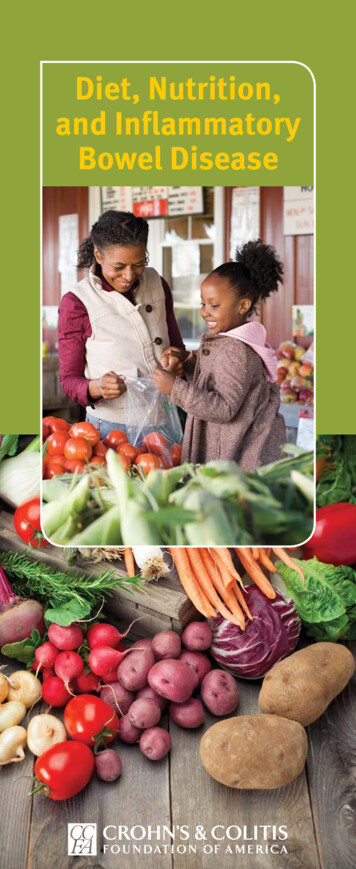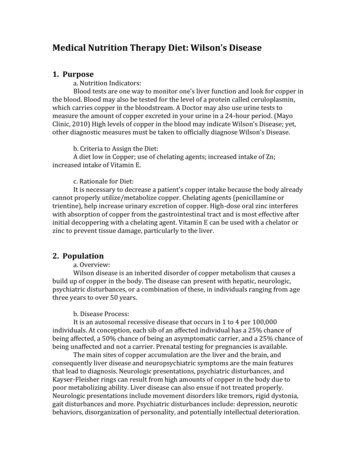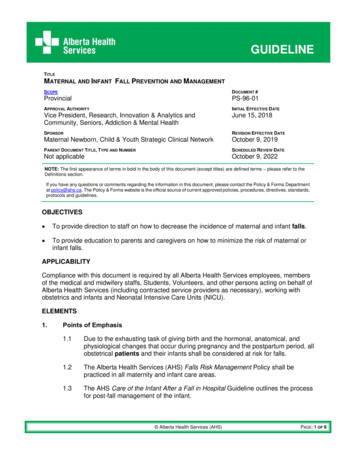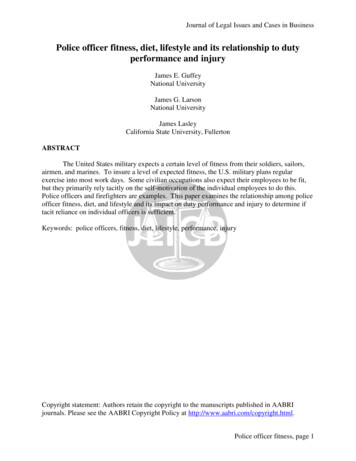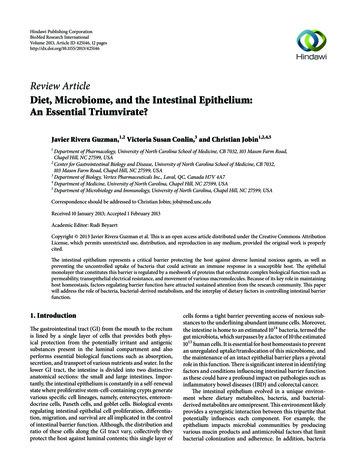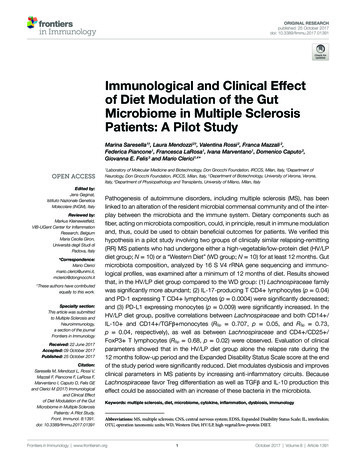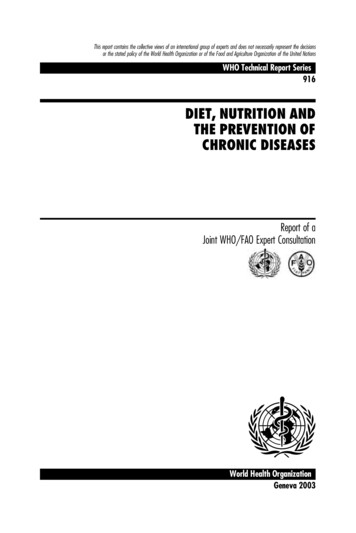
Transcription
This report contains the collective views of an international group of experts and does not necessarily represent the decisionsor the stated policy of the World Health Organization or of the Food and Agriculture Organization of the United NationsWHO Technical Report Series916DIET, NUTRITION ANDTHE PREVENTION OFCHRONIC DISEASESReport of aJoint WHO/FAO Expert ConsultationWorld Health OrganizationGeneva 2003
WHO Library Cataloguing-in-Publication DataJoint WHO/FAO Expert Consultation on Diet, Nutrition and the Prevention ofChronic Diseases (2002 : Geneva, Switzerland)Diet, nutrition and the prevention of chronic diseases: report of a joint WHO/FAO expertconsultation, Geneva, 28 January -- 1 February 2002.(WHO technical report series ; 916)1.Chronic disease -- epidemiology 2.Diet -- standards3.Feeding behavior 4.Energy metabolism 5.Motor activity6.Cost of illness I.Title II.Series.ISBN 92 4 120916 XISSN 0512-3054(NLM classification: QU 145)q World Health Organization 2003All rights reserved. Publications of the World Health Organization can be obtained from Marketing andDissemination, World Health Organization, 20 avenue Appia, 1211 Geneva 27, Switzerland (tel: 41 22791 2476; fax: 41 22 791 4857; e-mail: bookorders@who.int). Requests for permission to reproduce ortranslate WHO publications --- whether for sale or for noncommercial distribution --- should be addressedto Publications, at the above address (fax: 41 22 791 4806; e-mail: permissions@who.int).The designations employed and the presentation of the material in this publication do not imply theexpression of any opinion whatsoever on the part of the World Health Organization concerning the legalstatus of any country, territory, city or area or of its authorities, or concerning the delimitation of its frontiersor boundaries. Dotted lines on maps represent approximate border lines for which there may not yet befull agreement.The mention of specific companies or of certain manufacturers’ products does not imply that they areendorsed or recommended by the World Health Organization in preference to others of a similar naturethat are not mentioned. Errors and omissions excepted, the names of proprietary products aredistinguished by initial capital letters.The World Health Organization does not warrant that the information contained in this publication iscomplete and correct and shall not be liable for any damages incurred as a result of its use.This publication contains the collective views of an international group of experts and does notnecessarily represent the decisions or the stated policy of the World Health Organization or of the Foodand Agriculture Organization of the United Nations.Typeset and printed in Switzerland
Contents1. IntroductionReference132. Background2.1 The global burden of chronic diseases2.2 The double burden of diseases in the developing world2.3 An integrated approach to diet-related and nutrition-related diseasesReferences4489103. Global and regional food consumption patterns and trends3.1 Introduction3.2 Developments in the availability of dietary energy3.3 Availability and changes in consumption of dietary fat3.4 Availability and changes in consumption of animal products3.5 Availability and consumption of fish3.6 Availability and consumption of fruits and vegetables3.7 Future trends in demand, food availability and consumption3.8 ConclusionsReferences131314172022232527294. Diet, nutrition and chronic diseases in context4.1 Introduction4.2 Diet, nutrition and the prevention of chronic diseasesthrough the life course4.2.1 Fetal development and the maternal environment4.2.2 Infancy4.2.3 Childhood and adolescence4.2.4 Adulthood4.2.5 Ageing and older people4.3 Interactions between early and later factors throughout the life course4.3.1 Clustering of risk factors4.3.2 Intergenerational effects4.4 Gene--nutrient interactions and genetic susceptibility4.5 Intervening throughout lifeReferences30303131323438394041414142465. Population nutrient intake goals for preventing diet-related chronic diseases5.1 Overall goals5.1.1 Background5.1.2 Strength of evidence5.1.3 A summary of population nutrient intake goalsReferences545454545559iii
5.2 Recommendations for preventing excess weight gain and obesity5.2.1 Background5.2.2 Trends5.2.3 Diet, physical activity and excess weight gain and obesity5.2.4 Strength of evidence5.2.5 General strategies for obesity prevention5.2.6 Disease-specific recommendationsReferences5.3 Recommendations for preventing diabetes5.3.1 Background5.3.2 Trends5.3.3 Diet, physical activity and diabetes5.3.4 Strength of evidence5.3.5 Disease-specific recommendationsReferences5.4 Recommendations for preventing cardiovascular diseases5.4.1 Background5.4.2 Trends5.4.3 Diet, physical activity and cardiovascular disease5.4.4 Strength of evidence5.4.5 Disease-specific recommendationsReferences5.5 Recommendations for preventing cancer5.5.1 Background5.5.2 Trends5.5.3 Diet, physical activity and cancer5.5.4 Strength of evidence5.5.5 Disease-specific recommendationsReferences5.6 Recommendations for preventing dental diseases5.6.1 Background5.6.2 Trends5.6.3 Diet and dental disease5.6.4 Strength of evidence5.6.5 Disease-specific recommendationsReferences5.7 Recommendations for preventing osteoporosis5.7.1 Background5.7.2 Trends5.7.3 Diet, physical activity and osteoporosis5.7.4 Strength of evidence5.7.5 Disease-specific recommendationsReferences6. Strategic directions and recommendations for policy and research6.1 9129129130131132134134
6.2 Policy principles for the promotion of healthy dietsand physical activity6.3 Prerequisites for effective strategies6.3.1 Leadership for effective action6.3.2 Effective communication6.3.3 Functioning alliances and partnerships6.3.4 Enabling environments6.4 Strategic actions for promoting healthy diets and physical activity6.4.1 Surveillance of people’s diets, physical activityand related disease burden6.4.2 Enabling people to make informed choicesand take effective action6.4.3 Making the best use of standards and legislation6.4.4 Ensuring that ‘‘healthy diet’’ components are available to all6.4.5 Achieving success through intersectoral initiatives6.4.6 Making the best use of health services and theprofessionals who provide them6.5 Call to 3143143144Acknowledgements144AnnexSummary of the strength of evidence for obesity, type 2 diabetes,cardiovascular disease (CVD), cancer, dental disease and osteoporosis148v
Joint WHO/FAO Expert Consultation on Diet, Nutritionand the Prevention of Chronic DiseasesGeneva, 28 January--1 February 2002MembersDr E.K. Amine, Dean, High Institute of Public Health, Alexandria University,Alexandria, EgyptDr N.H. Baba, Chairperson, Department of Nutrition and Food Sciences, AmericanUniversity of Beirut, Beirut, LebanonDr M. Belhadj, Professor of Internal Medicine and Diabetologia, Centre HospitalierUniversitaire, Oran, AlgeriaDr M. Deurenberg-Yap, Director, Research and Information Management, HealthPromotion Board, Singapore (Co-Rapporteur)Dr A. Djazayery, Professor of Nutrition, Department of Nutrition and Biochemistry,School of Public Health, Tehran University of Medical Sciences, Tehran, IslamicRepublic of IranDr T. Forrester, Director, Tropical Medicine Research Institute, The University of theWest Indies, Kingston, JamaicaDr D.A. Galuska, Division of Nutrition and Physical Activity, National Center forChronic Disease, Prevention and Health Promotion, Centers for Disease Controland Prevention, Atlanta, GA, USADr S. Herman, Senior Researcher, Nutrition Research and Development Centre,Ministry of Health, Bogor, IndonesiaProfessor W.P.T. James, Chairman, International Obesity Task Force, London,EnglandDr J.R. M’Buyamba Kabangu, Hypertension Unit, Department of Internal Medicine,University of Kinshasa Hospital, Kinshasa, Democratic Republic of the CongoProfessor M.B. Katan, Division of Human Nutrition and Epidemiology, WageningenUniversity, Wageningen, NetherlandsDr T.J. Key, Cancer Research UK, Epidemiology Unit, University of Oxford, TheRadcliffe Infirmary, Oxford, EnglandProfessor S. Kumanyika, Center for Clinical Epidemiology and Biostatistics, School ofMedicine, University of Pennsylvania, Philadelphia, PA, USA (Vice-Chairperson)Professor J. Mann, Department of Human Nutrition, University of Otago, Dunedin,New ZealandDr P.J. Moynihan, School of Dental Sciences, University of Newcastle-upon-Tyne,Newcastle-upon-Tyne, EnglandDr A.O. Musaiger, Director, Environmental and Biological Programme, BahrainCentre for Studies and Research, Manama, BahrainDr G.W. Olwit, Kampala, UgandaDr J. Petkeviciene, Institute for Biomedical Research, Kaunas Medical University,Kaunas, Lithuaniavi
Dr A. Prentice, Director, Human Nutrition Research, Medical Research Council,Cambridge, EnglandProfessor K.S. Reddy, Department of Cardiology, Cardiothoracic Centre, All IndiaInstitute of Medical Science, New Delhi, IndiaDr A. Schatzkin, Nutritional Epidemiology Branch, National Cancer Institute, NationalInstitute of Health, Rockville, MD, USAProfessor J.C. Seidell, National Institute of Public Health and the Environment,Bilthoven, Netherlands (Co-Rapporteur)Dr A.P. Simopoulos, President, The Center for Genetics, Nutrition and Health,Washington, DC, USAProfessor S. Srianujata, Director, Institute of Nutrition, Mahidol University, NakhonPathom, ThailandDr N. Steyn, Chronic Diseases of Lifestyle, Medical Research Council, Tygerberg,South AfricaProfessor B. Swinburn, School of Health Sciences, Deakin University, Melbourne,Victoria, AustraliaDr R. Uauy, Institute of Nutrition and Food Technology, University of Chile, Santiago,Chile; and Department of Epidemiology and Population Health, London School ofHygiene and Tropical Medicine, London, England (Chairperson)Dr M. Wahlqvist, Director, Asia Pacific Health and Nutrition Centre, Monash AsiaInstitute, Monash University, Melbourne, Victoria, AustraliaProfessor Wu Zhao-Su, Institute of Heart, Lung and Blood Vessel Diseases, Beijing,ChinaDr N. Yoshiike, Division of Health and Nutrition Monitoring, National Institute of Healthand Nutrition, Tokyo, JapanRepresentatives of other organizations*United Nations Administrative Committee on Coordination/Subcommittee on Nutrition(ACC/SCN),Dr S. Rabenek, Technical Secretary, ACC/SCN, Geneva, SwitzerlandSecretariat{Dr K. Bagchi, Regional Adviser, Nutrition, Food Security and Safety, WHO RegionalOffice for the Eastern Mediterranean, Cairo, EgyptDr T. Cavalli-Sforza, Regional Adviser, Nutrition, WHO Regional Office for the WesternPacific, Manila, Philippines*Unable to attend: International Atomic Energy Agency, Vienna, Austria; Secretariat of the PacificCommunity, Noumea, New Caledonia; United Nations Children’s Fund, New York, NY, USA; UnitedNations University, Tokyo, Japan; World Bank, Washington, DC, USA.{Unable to attend: Dr H. Delgado, Director, Institute of Nutrition of Central America and Panama,Guatemala City, Guatemala; Dr F.J. Henry, Director, Caribbean Food and Nutrition Institute, TheUniversity of the West Indies, Kingston, Jamaica.vii
Dr G.A. Clugston, Director, Department of Nutrition for Health and Development,Sustainable Development and Healthy Environments, WHO, Geneva, SwitzerlandDr I. Darnton-Hill, Department of Noncommunicable Disease Prevention and HealthPromotion, Noncommunicable Diseases and Mental Health, WHO, Geneva,SwitzerlandProfessor A. Ferro-Luzzi, National Institute for Food and Nutrition Research, Rome,Italy (Temporary Adviser)Dr J. Leowski, Regional Adviser, Noncommunicable Diseases, WHO Regional Officefor South-East Asia, New Delhi, IndiaDr C. Nishida, Department of Nutrition for Health and Development, SustainableDevelopment and Healthy Environments, WHO, Geneva, Switzerland (Secretary)Dr D. Nyamwaya, Medical Officer, Health Promotion, WHO Regional Office for Africa,Harare, ZimbabweDr A. Ouedraogo, Regional Officer, Nutrition, WHO Regional Office for Africa, Harare,ZimbabweDr P. Pietinen, Department of Noncommunicable Disease Prevention and HealthPromotion, Noncommunicable Diseases and Mental Health, WHO, Geneva,SwitzerlandDr P. Puska, Director, Department of Noncommunicable Disease Prevention andHealth Promotion, Noncommunicable Diseases and Mental Health, WHO,Geneva, SwitzerlandDr E. Riboli, International Agency for Research on Cancer, Lyon, FranceDr A. Robertson, Regional Adviser, Nutrition and Food Security Programme, WHORegional Office for Europe, Copenhagen, DenmarkDr P. Shetty, Chief, Nutrition Planning, Assessment and Evaluation Service, Food andNutrition Division, FAO, Rome, ItalyDr R. Weisell, Nutrition Planning, Assessment and Evaluation Service, Food andNutrition Division, FAO, Rome, ItalyDr D. Yach, Executive Director, Noncommunicable Diseases and Mental Health,WHO, Geneva, Switzerlandviii
AbbreviationsThe following abbreviations are used in this report:ACCUnited Nations Administrative Committee on CoordinationAIDSacquired immunodeficiency syndromeBMIbody mass indexCARMENCarbohydrate Ratio Management in European National dietsCHDcoronary heart diseaseCVDcardiovascular diseaseDALYdisability-adjusted life yearDASHdietary approaches to stop hypertensionDEXAdual-energy X-ray absorptiometryDHAdocosahexaenoic aciddmfdecayed, missing, filled primary (teeth)DMFdecayed, missing, filled permanent (teeth)dmftdecayed, missing, filled primary teethDMFTdecayed, missing, filled permanent teethDONALDDortmund Nutritional and Anthropometric LongitudinallyDesigned StudyECCearly childhood cariesEPAeicosapentaenoic acidEPICEuropean Prospective Investigation into Cancer and NutritionERGOBEuropean Research Group for Oral BiologyFAOSTATFood and Agricultural Organization of the United NationsStatistical DatabasesFERfat to energy ratioGDPgross domestic productGISSIGruppo Italiano por lo Studio della Sopravvivenza nell’InfartoMiocardicoGNPgross national productHBPhigh blood pressureHDLhigh-density lipoproteinHFIhereditary fructose intoleranceHIVhuman immunodeficiency virusHOPEHeart Outcomes Prevention EvaluationIARCInternational Agency for Research on CancerIDDMinsulin-dependent diabetes mellitusIGTimpaired glucose toleranceIHDischaemic heart diseaseix
1xIUGRintrauterine growth retardationLDLlow-density lipoproteinMGRSmulticentre growth reference study (i.e. the WHO MGRS study)mRNAmessenger ribonucleic acidMSGmonosodium glutamateMUFAmonounsaturated fatty acidNCDnoncommunicable diseaseNGOnongovernmental organizationNIDDMnon-insulin-dependent diabetes mellitusNSPnon-starch polysaccharidesPUFApolyunsaturated fatty acidRCTrandomized controlled trialSCNACC Subcommittee on Nutrition1SFAsaturated fatty acidT1DMtype 1 diabetesT2DMtype 2 diabetesVLDLvery low-density lipoproteinWCRFWorld Cancer Research FundWHRwaist:hip circumference ratio or waist:hip ratioIn April 2002 the name of the Subcommittee on Nutrition was changed to the United Nations SystemStanding Committee on Nutrition.
1.IntroductionA Joint WHO/FAO Expert Consultation on Diet, Nutrition and thePrevention of Chronic Diseases met in Geneva from 28 January to1 February 2002. The meeting was opened by Dr D. Yach, ExecutiveDirector, Noncommunicable Diseases and Mental Health, WHO, onbehalf of the Directors-General of the Food and Agriculture Organizationof the United Nations and the World Health Organization. TheConsultation followed up the work of a WHO Study Group on Diet,Nutrition and Prevention of Noncommunicable Diseases, which had metin 1989 to make recommendations regarding the prevention of chronicdiseases and the reduction of their impact (1). The Consultationrecognized that the growing epidemic of chronic disease afflicting bothdeveloped and developing countries was related to dietary and lifestylechanges and undertook the task of reviewing the considerable scientificprogress that has been made in different areas. For example, there is betterepidemiological evidence for determining certain risk factors, and theresults of a number of new controlled clinical trials are now available. Themechanisms of the chronic disease process are clearer, and interventionshave been demonstrated to reduce risk.During the past decade, rapid expansion in a number of relevantscientific fields and, in particular, in the amount of population-basedepidemiological evidence has helped to clarify the role of diet inpreventing and controlling morbidity and premature mortality resultingfrom noncommunicable diseases (NCDs). Some of the specific dietarycomponents that increase the probability of occurrence of these diseasesin individuals, and interventions to modify their impact, have also beenidentified.Furthermore, rapid changes in diets and lifestyles that have occurredwith industrialization, urbanization, economic development and marketglobalization, have accelerated over the past decade. This is having asignificant impact on the health and nutritional status of populations,particularly in developing countries and in countries in transition. Whilestandards of living have improved, food availability has expanded andbecome more diversified, and access to services has increased, there havealso been significant negative consequences in terms of inappropriatedietary patterns, decreased physical activities and increased tobacco use,and a corresponding increase in diet-related chronic diseases, especiallyamong poor people.Food and food products have become commodities produced andtraded in a market that has expanded from an essentially local base to anincreasingly global one. Changes in the world food economy are1
reflected in shifting dietary patterns, for example, increased consumption of energy-dense diets high in fat, particularly saturated fat, and lowin unrefined carbohydrates. These patterns are combined with a declinein energy expenditure that is associated with a sedentary lifestyle --motorized transport, labour-saving devices in the home, the phasing outof physically demanding manual tasks in the workplace, and leisure timethat is preponderantly devoted to physically undemanding pastimes.Because of these changes in dietary and lifestyle patterns, chronic NCDs--- including obesity, diabetes mellitus, cardiovascular disease (CVD),hypertension and stroke, and some types of cancer --- are becomingincreasingly significant causes of disability and premature death in bothdeveloping and newly developed countries, placing additional burdenson already overtaxed national health budgets.The Consultation provided an opportune moment for FAO and WHOto draw on the latest scientific evidence available and to updaterecommendations for action to governments, international agencies andconcerned partners in the public and private sectors. The overall aim ofthese recommendations is to implement more effective and sustainablepolicies and strategies to deal with the increasing public health challengesrelated to diet and health.The Consultation articulated a new platform, not just of dietary andnutrient targets, but of a concept of the human organism’s subtle andcomplex relationship to its environment in relation to chronic diseases.The discussions took into account ecological, societal and behaviouralaspects beyond causative mechanisms. The experts looked at diet withinthe context of the macroeconomic implications of public healthrecommendations on agriculture, and the global supply and demand forfoodstuffs, both fresh and processed. The role of diet in defining theexpression of genetic susceptibility to NCDs, the need for responsible andcreative partnerships with both traditional and non-traditional partners,and the importance of addressing the whole life course, were all recognized.Nutrition is coming to the fore as a major modifiable determinant ofchronic disease, with scientific evidence increasingly supporting the viewthat alterations in diet have strong effects, both positive and negative, onhealth throughout life. Most importantly, dietary adjustments may notonly influence present health, but may determine whether or not anindividual will develop such diseases as cancer, cardiovascular diseaseand diabetes much later in life. However, these concepts have not led to achange in policies or in practice. In many developing countries, foodpolicies remain focused only on undernutrition and are not addressingthe prevention of chronic disease.2
Although the primary purpose of the Consultation was to examine anddevelop recommendations for diet and nutrition in the prevention ofchronic diseases, the need for sufficient physical activity was alsodiscussed and is therefore emphasized in the report. This emphasis isconsistent with the trend to consider physical activity alongside thecomplex of diet, nutrition and health. Some relevant aspects include:. Energy expenditure through physical activity is an important part ofthe energy balance equation that determines body weight. A decreasein energy expenditure through decreased physical activity is likely to beone of the major factors contributing to the global epidemic ofoverweight and obesity.Physical activity has great influence on body composition --- on theamount of fat, muscle and bone tissue.To a large extent, physical activity and nutrients share the samemetabolic pathways and can interact in various ways that influence therisk and pathogenesis of several chronic diseases.Cardiovascular fitness and physical activity have been shown to reducesignificantly the effects of overweight and obesity on health.Physical activity and food intake are both specific and mutuallyinteracting behaviours that are and can be influenced partly by thesame measures and policies.Lack of physical activity is already a global health hazard and is aprevalent and rapidly increasing problem in both developed anddeveloping countries, particularly among poor people in large cities.In order to achieve the best results in preventing chronic diseases, thestrategies and policies that are applied must fully recognize the essentialrole of diet, nutrition and physical activity.This report calls for a shift in the conceptual framework for developingstrategies for action, placing nutrition --- together with the otherprincipal risk factors for chronic disease, namely, tobacco use andalcohol consumption --- at the forefront of public health policies andprogrammes.Reference1.Diet, nutrition, and the prevention of chronic diseases. Report of a WHO StudyGroup. Geneva, World Health Organization, 1990 (WHO Technical Report Series,No. 797).3
2.Background2.1The global burden of chronic diseasesDiet and nutrition are important factors in the promotion andmaintenance of good health throughout the entire life course. Theirrole as determinants of chronic NCDs is well established and theytherefore occupy a prominent position in prevention activities (1).The latest scientific evidence on the nature and strength of the linksbetween diet and chronic diseases is examined and discussed in detail inthe following sections of this report. This section gives an overall view ofthe current situation and trends in chronic diseases at the global level.The chronic diseases considered in this report are those that are related todiet and nutrition and present the greatest public health burden, either interms of direct cost to society and government, or in terms of disabilityadjusted life years (DALYs). These include obesity, diabetes, cardiovascular diseases, cancer, osteoporosis and dental diseases.The burden of chronic diseases is rapidly increasing worldwide. It hasbeen calculated that, in 2001, chronic diseases contributed approximately 60% of the 56.5 million total reported deaths in the world andapproximately 46% of the global burden of disease (1). The proportionof the burden of NCDs is expected to increase to 57% by 2020. Almosthalf of the total chronic disease deaths are attributable to cardiovasculardiseases; obesity and diabetes are also showing worrying trends, not onlybecause they already affect a large proportion of the population, but alsobecause they have started to appear earlier in life.The chronic disease problem is far from being limited to the developedregions of the world. Contrary to widely held beliefs, developingcountries are increasingly suffering from high levels of public healthproblems related to chronic diseases. In five out of the six regions ofWHO, deaths caused by chronic diseases dominate the mortalitystatistics (1). Although human immunodeficiency virus/acquiredimmunodeficiency syndrome (HIV/AIDS), malaria and tuberculosis,along with other infectious diseases, still predominate in sub-SaharanAfrica and will do so for the foreseeable future, 79% of all deathsworldwide that are attributable to chronic diseases are already occurringin developing countries (2).It is clear that the earlier labelling of chronic diseases as ‘‘diseases ofaffluence’’ is increasingly a misnomer, as they emerge both in poorercountries and in the poorer population groups in richer countries. Thisshift in the pattern of disease is taking place at an accelerating rate;furthermore, it is occurring at a faster rate in developing countries than itdid in the industrialized regions of the world half a century ago (3). This4
rapid rate of change, together with the increasing burden of disease, iscreating a major public health threat which demands immediate andeffective action.It has been projected that, by 2020, chronic diseases will account foralmost three-quarters of all deaths worldwide, and that 71% of deathsdue to ischaemic heart disease (IHD), 75% of deaths due to stroke, and70% of deaths due to diabetes will occur in developing countries (4). Thenumber of people in the developing world with diabetes will increase bymore than 2.5-fold, from 84 million in 1995 to 228 million in 2025 (5). Ona global basis, 60% of the burden of chronic diseases will occur indeveloping countries. Indeed, cardiovascular diseases are even nowmore numerous in India and China than in all the economicallydeveloped countries in the world put together (2). As for overweight andobesity, not only has the current prevalence already reached unprecedented levels, but the rate at which it is annually increasing in mostdeveloping regions is substantial (3). The public health implications ofthis phenomenon are staggering, and are already becoming apparent.The rapidity of the changes in developing countries is such that a doubleburden of disease may often exist. India, for example, at present faces acombination of communicable diseases and chronic diseases, with theburden of chronic diseases just exceeding that of communicable diseases.Projections nevertheless indicate that communicable diseases will stilloccupy a critically important position up to 2020 (6). Another eloquentexample is that of obesity, which is becoming a serious problemthroughout Asia, Latin America and parts of Africa, despite thewidespread presence of undernutrition. In some countries, the prevalence of obesity has doubled or tripled over the past decade.Chronic diseases are largely preventable diseases. Although more basicresearch may be needed on some aspects of the mechanisms that link dietto health, the currently available scientific evidence provides asufficiently strong and plausible basis to justify taking action now.Beyond the appropriate medical treatment for those already affected, thepublic health approach of primary prevention is considered to be themost cost-effective, affordable and sustainable course of action to copewith the chronic disease epidemic worldwide. The adoption of a commonrisk-factor approach to chronic disease prevention is a major development in the thinking behind an integrated health policy. Sometimeschronic diseases are considered communicable at the risk factor level (7).Modern dietary patterns and physical activity patterns are riskbehaviours that travel across countries and are transferable from onepopulation to another like an infectious disease, affecting diseasepatterns globally.5
While age, sex and genetic susceptibility are non-modifiable, many of therisks associated with age and sex are modifiable. Such risks includebehavioural factors (e.g. diet, physical inactivity, tobacco use, alcoholconsumption); biological factors (e.g. dyslipidemia, hypertension,overweight, hyperinsulinaemia); and finally societal factors, whichinclude a complex mixture of interacting socioeconomic, cultural andother environmental parameters.Diet has been known for many years to play a key role as a risk factor forchronic diseases. What is apparent at the global level is that greatchanges have swept the entire world since the second half of the twentiethcentury, inducing major modifications in diet, first in industrial regionsand more recently in developing countries. Traditional, largely plantbased diets have been swiftly replaced by high-fat, energy-dense dietswith a substantial content of animal-based foods. But diet, while criticalto prevention, is just one risk factor. Physical inactivity, now recognizedas an increasingly important determinant of health, is the result of aprogressive shift of lifestyle towards more sedentary patterns, indeveloping countries as much as in industrialized ones. Recent datafrom São Paulo, Brazil, for example, indicate that 70--80% of thepopulation are remarkably inactive (8). The combination of these andother risk factors, such as tobacco use, is likely to have an additive oreven a multiplier effect, capable of accelerating the pace at which thechronic disease epidemic is emerging in the developing countries.The need for action to strengthen control and prevention measures tocounter the spread of the chronic disease epidemic is now widelyrecognized by many countries, but the developing countries are laggingbehind in implementing such measures. Encouragingly, however, effortsto counteract the rise in chronic dis
4. Diet, nutrition and chronic diseases in context 30 4.1 Introduction 30 4.2 Diet, nutrition and the prevention of chronic diseases through the life course 31 4.2.1 Fetal development and the maternal environment 31 4.2.2 Infancy 32 4.2.3 Childhood and adolescen

